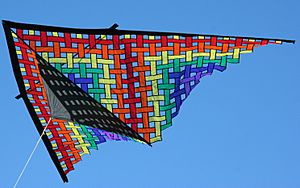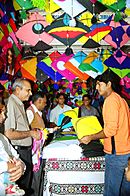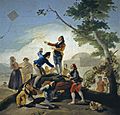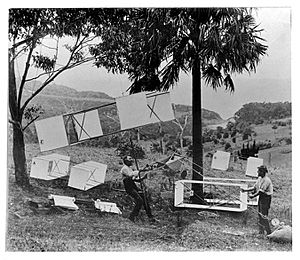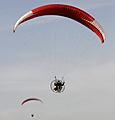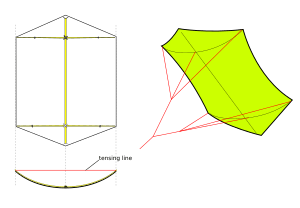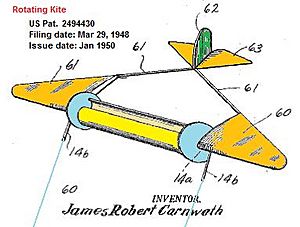Kite types facts for kids
Kites are amazing flying objects that use the wind to lift into the sky. They are held by a string or line, and they fly because of how the wind moves over their surfaces, creating lift. Kites can fly in the air, but some special ones can even fly in water or other liquids!
Kites come in all sorts of shapes, sizes, and materials. Their design can be very simple or super complex, depending on what they are used for and how they are flown.
Contents
- How Kites Are Made
- What Kites Are Made Of
- Different Wing Shapes
- Kites and Buoyancy
- How Kites Are Controlled
- Kite Stability
- Cool Types of Kites
- Advertising Kites
- Airplane Kites
- Arch Kites
- Art Kites
- Autogyro Kites
- Bag Kites
- Balloon Kites (Kytoons)
- Barn Door Kites
- Bell Kites
- Bermuda Kites
- Bird Kites
- Boat Kites
- Box Kites
- Butterfly Kites
- C-Kites
- Cambodian Kites
- Cellular Kites
- Chapi-chapi
- Chinese Kites
- Cody Kites
- Cup Kites
- Delta Kites
- Diamond Kites
- Display Kites
- Dragon Kites
- Electricity-Generating Kites
- Fighter Kites
- Figure Kites
- Fishing Kites
- Foil Kites
- Hang Gliders
- Hargrave Kites
- Helikites
- Historical Kites
- Hydro Kites
- Indoor Kites
- Jalbert Parafoil Kites
- Japanese Kites
- Kid Kites
- Killer Kites
- Korean Kites
- Kytoon
- Laddermill
- Leaf Kites
- LEI Kites
- Light-Emitting Kites
- Manned Kites
- Miniature Kites
- Musical Kites
- Night Kites
- Novelty Kites
- Octopus Kites
- Parachute Kites
- Parafoil Kites
- Paragliders
- Parasails
- Paravanes
- Powered Paragliders
- Quick Kites
- Radio-Controlled Kites
- Ram-Air Kites
- Recycled Kites
- Revolution Kites
- Ribbon Kites
- Rigid Kites
- Rogallo Parawing Kites
- Rokkaku Kites
- Rotary Kites
- Sail Kites
- Sled Kites
- Soft Kites
- Solar Kites
- Sound-Making Kites
- Square Kites
- Stacked Kites
- Stunt Kites
- Styrofoam Kites
- Target Kites
- Tetrahedral Kites
- Thai Kites
- Toy Kites
- Traction Kites
- Trainer Kites
- Train or Kite Train
- Underwater Kites
- Water Relaunchable Kites
- Work Kites
- Zero-Wind Kites
- See also
How Kites Are Made
Kites can be built by people at home as a fun project, or they can be made by special companies that design and sell kites. These companies often belong to groups that help kite makers and shops work together.
What Kites Are Made Of
Kites are made from many different things. Here are some common materials:
- Plastic: Like lightweight foam, which is easy to shape.
- Natural materials: Such as strong plant leaves or even grass.
- Paper: A classic and simple material for many kites.
- Fabrics: Strong cloths like rip-stop nylon (which doesn't tear easily), regular nylon, or Dacron are popular for durable kites.
Different Wing Shapes
Kites have many different wing designs, which affect how they fly:
- Single wing: Most kites have one main wing.
- Flexible sail: Some kites have soft, bendy wings.
- Stiffened sail: These have flexible wings with added sticks or rods to make them stronger.
- Rigid wing: Kites with hard, unbending wings.
- Multiple wings: Like biplanes (two wings) or multiplane kites (many wings).
- Ram-air inflated: These kites fill with air as they fly, like a parachute.
- Rotating wing: Kites that spin to create lift, also called rotor kites.
Flying Many Kites Together
Sometimes, people fly many kites at once! This can be a single kite with several wings, or many separate kites linked together in a line, like a "kite train." There are even world records for how many kites can be flown in one train! Huge kite systems might need a team of people to fly them.
Kites and Buoyancy
Most kites are heavier than the air they fly in, so they need wind to stay up. But some special kites, called Kytoons, are filled with lighter-than-air gases (like helium). This helps them float even when there's no wind. When the wind blows, they fly like a regular kite.
Kites that fly in water (hydrodynamic kites) can also be designed to float, sink, or stay neutral, using the water's movement to steer.
How Kites Are Controlled
Kites are usually controlled by moving their strings or "tether lines." For some advanced kites, you can even change how much lifting gas they have, or use special parts on the wing to steer them, just like an airplane.
Kite Stability
Just like airplanes, kites can be stable, neutral, or unstable.
- Stable kites tend to fly straight and return to a steady position on their own.
- Neutral or unstable kites need constant steering and adjustments from the pilot to stay in the right place.
Cool Types of Kites
There are so many different kinds of kites! Here are some interesting ones:
-
Peter Lynn holds the world record for the largest kite!
Advertising Kites
These kites are used to show off advertisements, company logos, or messages for different causes. You might see them at events or over businesses.
Airplane Kites
Some kites are shaped like airplanes. Very large ones are even being used to explore new ways of making clean energy!
Arch Kites
An arch kite can be a single kite shaped like an arch, or it can be many kites connected in a long arching line. Some arch kites even spin!
Art Kites
These kites are like flying artworks! They can have beautiful paintings, detailed designs, or be part of sculptures. Some are even used in video art or photography.
-
A painting from 1778 by Francisco Goya showing a simple square kite.
Autogyro Kites
Also called gyro kites or helicopter kites, these kites have spinning blades that help them stay in the air, similar to how a helicopter works, but without an engine.
Bag Kites
These are simple kites made from paper or plastic bags. They often keep the basic shape of the bag.
Balloon Kites (Kytoons)
A kytoon is a mix of a balloon and a kite. It's filled with a lighter-than-air gas, so it floats like a balloon. But it also has a kite shape, so it can fly and be steered in the wind. Kytoons are great for lifting radio antennas or rescue signals high up.
Barn Door Kites
These kites look a lot like a diamond kite, but they have two diagonal sticks that cross vertically, making them very stable.
Bell Kites
These kites were designed by Alexander Graham Bell, who also invented the telephone!
Bermuda Kites
These are traditional kites flown in Bermuda, especially around Easter. They are known for flying very high and staying in the air for a long time.
Bird Kites
These kites are designed to look like birds, either in a simple way or very realistically. Some even move like birds in the sky!
Boat Kites
Some boats are designed to be "kited" or pulled through the air by a tow line. In the past, there were even glider boats that could be released to glide for miles!
Box Kites
Box kites are famous for their strong, box-like shape, often made of several cells stacked together.
Butterfly Kites
These kites are shaped and decorated to look like beautiful butterflies, sometimes even moving their "wings" as they fly.
C-Kites
These kites have a deep "C" shape when inflated, often used for sports like kitesurfing.
Cambodian Kites
The Kleng Ek kite is a famous Cambodian musical kite, often flown at night. It makes a special sound in the wind.
Cellular Kites
These kites are made up of many small cells or compartments, giving them a complex, often box-like structure.
Chapi-chapi
A popular kite in the Philippines, often made from simple materials like old broomsticks and newspapers.
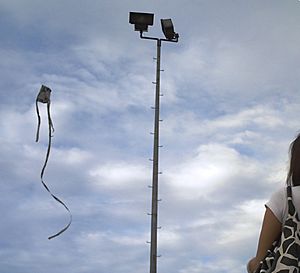
Chinese Kites
China has a rich history of kite making, with many unique styles from different regions like Beijing and Weifang, known for their beautiful designs and craftsmanship.
Cody Kites
These were large, powerful kites designed by Samuel Franklin Cody for military uses, like lifting people or equipment.
Cup Kites
These creative kites are made mostly from cups, often paper or foam cups, linked together to form a flying shape.
Delta Kites
Delta kites have a triangular, delta-wing shape, similar to a modern jet airplane. They can be single-line kites or two-line stunt kites.
Diamond Kites
The classic diamond shape is one of the most common and recognizable kite types, from small beginner kites to large, high-performance ones.
Display Kites
These are large, impressive kites designed to be shown at festivals, shows, and exhibitions because of their size, beauty, or unique design.
Dragon Kites
Dragon kites can be shaped like a single dragon or be a long "train" of many kite sections linked together to look like a giant dragon flying through the sky.
Electricity-Generating Kites
Some kites are specially designed to create electricity from the wind, offering a new way to get clean energy.
Fighter Kites
Fighter kites are designed for "kite fighting," where pilots try to cut the strings of other kites in the sky. They are often fast and maneuverable.
Figure Kites
These kites are shaped to look like animals, insects, people, or other objects, making them very fun and artistic.
Fishing Kites
These kites are used to carry fishing bait out over the water, helping anglers reach fish that are far from shore.
Foil Kites
Also known as parafoil kites, these are soft, flexible kites that inflate with air when flown, similar to a parachute. They are often used for power kiting.
Hang Gliders
Many Hang gliders are actually a type of manned kite! When a person is flying a hang glider, they are essentially being "kited" by the wind.
Hargrave Kites
These kites were invented by Lawrence Hargrave, an Australian engineer. He designed box kites that could lift a person, which was a big step in aviation history.
Helikites
A Helikite is a special kite that combines a kite and a helium balloon. This allows it to fly in very light winds or even no wind, and also handle strong winds. They are used for things like photography, military surveillance, and lifting antennas.
Historical Kites
These are kites built to look exactly like important kites from the past, sometimes based on old patent drawings, to show how kite design has changed over time.
Hydro Kites
These are kites that fly in water or on the surface of water, instead of air. They are used for scientific research or even to pull boats.
Indoor Kites
These are very lightweight kites designed to be flown indoors, where there is no wind, or in very still air conditions.
Jalbert Parafoil Kites
Named after Domina Jalbert, who invented the parafoil kite. This design is very important and is used in many modern kites, including paragliders.
Japanese Kites
Japan has a long tradition of kite making, with many unique and artistic designs, often used in festivals and celebrations.
Kid Kites
These kites are designed to be easy and safe for young children to fly, often small and simple.
Killer Kites
This term has a few meanings: 1. Kites used in kite fighting to cut the lines of other kites. 2. Sadly, kites that have caused injuries or deaths, usually due to sharp lines or metallic parts. 3. Kites that are simply incredibly impressive or exciting to watch!
Korean Kites
Korea also has a rich kite culture, with traditional designs and kite fighting.
Kytoon
(See "Balloon Kites" above)
Laddermill
A complex system of many small kites linked in a loop, often used to generate electricity.
Leaf Kites
Some traditional kites are made from large, strong leaves, especially in certain parts of the world.
LEI Kites
LEI stands for "Leading-Edge Inflated." These kites have a tube along their front edge that inflates with air, giving them a rigid shape. They are very popular for kitesurfing.
Light-Emitting Kites
These kites have lights on them, either powered by batteries or by electricity generated by the kite itself, making them visible and beautiful at night.
Manned Kites
These are kites large enough to lift a person into the air, like early experiments in flight or modern hang gliders.
Miniature Kites
These are tiny kites, sometimes small enough to fit in your hand, often made as art pieces.
Musical Kites
Some kites, like the Cambodian Ek kite, have devices that make music or sounds as the wind blows through them.
Night Kites
Kites designed to be flown after dark, often with lights or reflective materials.
Novelty Kites
These are kites with unusual or funny shapes and designs, made just for fun and to stand out.
Octopus Kites
Large, impressive kites shaped like an octopus, with long, flowing tentacles.
Parachute Kites
These are parachutes that have been changed to act like a kite, meaning they can be steered and create lift, not just slow a fall.
Parafoil Kites
(See "Foil Kites" above)
Paragliders
Paragliders are large, soft wings that people use to fly. They are a type of manned kite, as the pilot is "kited" by the wind.
Parasails
Parasails are modified parachutes that are towed behind a boat, lifting a person into the air. They are designed to create lift, making them a type of kite.
Paravanes
A paravane is a special type of water kite used underwater, often to pull things or for scientific research.
Powered Paragliders
These are paragliders with a small engine and propeller worn by the pilot, allowing them to take off and fly without needing a hill or tow.
Quick Kites
These are kites that can be made very quickly, often from simple, everyday materials, without needing special tools.
Radio-Controlled Kites
These kites can be steered using a radio remote control, allowing for very precise movements and tricks.
Ram-Air Kites
These kites have open sections that fill with wind, inflating the kite and giving it its shape and strength. Many power kites are ram-air kites.
Recycled Kites
Kites made from old or used materials, giving new life to things that might have been thrown away.
Revolution Kites
These are special stunt kites with four lines, allowing pilots to make them fly backward, spin, and perform amazing tricks.
Ribbon Kites
These kites are made of long ribbons, sometimes spinning or arranged in an arch shape, creating a beautiful effect in the sky.
Rigid Kites
Unlike soft kites, rigid kites have a completely stiff frame and wing, with no flexible parts.
Rogallo Parawing Kites
Invented by Francis Rogallo, the parawing is a flexible, often triangular kite design that was important in the development of hang gliders and paragliders.
Rokkaku Kites
A traditional Japanese hexagonal (six-sided) kite, known for its stability and often used in kite fighting.
Rotary Kites
These kites spin as they fly, using the spinning motion to create lift, similar to a propeller.
Sail Kites
These are kites used to pull things, like boats on water, buggies on land, or skiers on snow. They act like sails, harnessing the wind's power.
-
Kiteboarding uses a sail kite to pull a board.
Sled Kites
Sled kites are simple, often frameless kites that inflate with wind to create a pocket that catches the air.
Soft Kites
These kites have no rigid frame and get their shape from the wind filling them, like parafoils or sled kites.
Solar Kites
These kites are designed to fly in space, using the pressure of sunlight (photons) for propulsion, expanding the idea of what a "kite" can be!
Sound-Making Kites
Some kites have special parts that create sounds, like hummers or whistles, as they fly in the wind.
Square Kites
Simple, often flat kites with a basic square shape.
Stacked Kites
This is when several kite units are connected and flown one above the other on the same line.
Stunt Kites
Stunt kites are designed for tricks and maneuvers, often with two or more lines for precise control.
Styrofoam Kites
Kites made primarily from Styrofoam or similar foam materials, often using recycled foam plates or cups.
Target Kites
These kites were designed for military training, used as moving targets for gunnery practice. Image:Corner-reflector.svg
Tetrahedral Kites
These kites are made of many small pyramid (tetrahedron) shapes connected together. Alexander Graham Bell was very interested in these kites.
Thai Kites
Thailand has a rich tradition of kite flying, with unique designs and kite fighting competitions.
Toy Kites
Simple, often inexpensive kites designed for casual fun, usually single-line and easy to fly.
Traction Kites
These are powerful kites used to pull people or vehicles, like in kitesurfing, kiteboarding, or landboarding.
Trainer Kites
Smaller, less powerful kites used by beginners to learn how to control a kite before moving on to larger, more powerful ones.
Train or Kite Train
A kite train is when many separate kite bodies are connected along a single line, creating a long, impressive display in the sky. Dragon kites are a great example.
Underwater Kites
(See "Hydro Kites" and "Paravanes" above) These kites fly in water, used for science or industry.
Water Relaunchable Kites
These are air kites designed so that if they fall into the water, they can be easily launched back into the air by the pilot.
Work Kites
These kites are designed to perform specific tasks or generate energy. For example, some kites are used to pull ships, and others are being developed to generate electricity from high-altitude winds.
Zero-Wind Kites
These are very lightweight kites that can be flown indoors or in conditions with almost no wind, often by walking or gently "pumping" the kite line.
See also
- Ballooning (spider) (how baby spiders use silk to "kite" through the air)
- Kite applications
- Kite control systems
- Kite mooring
- List of surface water sports


